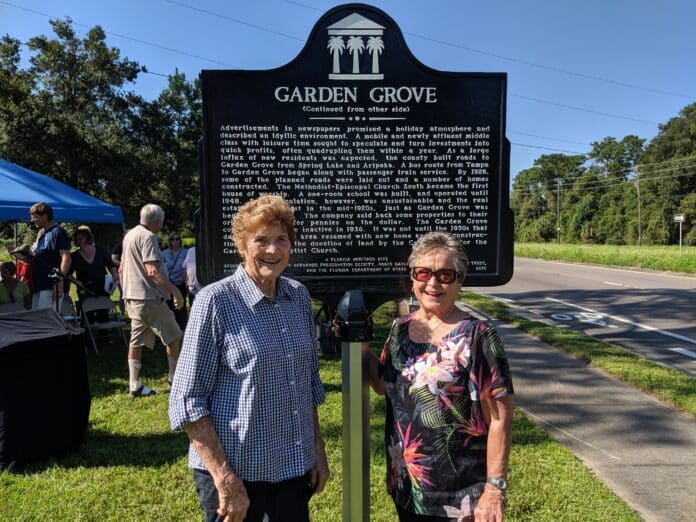On Saturday, Sept. 7, 2019, members of the First Baptist Church of Garden Grove unveiled a historic marker, commemorating the area of rich history whose surviving families first homesteaded the area in the late 1800s.
Garden Grove began as a planned development, whose growth was stunted in the 30s, when the housing market slowed.
Just a block north of the intersection of Highway 41 and Spring Hill Drive, is a plat of land on which a school was built. The school later became a polling precinct, and most recently the original Baptist church. The original buildings unfortunately burned down in the eighties.
The land belonged to Elisa and Elaine Crum’s family, whose father donated the land to the church.
The younger of the two sisters in attendance, Elaine Crum-Sullivan recalled how the one room schoolhouse was used as a polling precinct when she attended school in the city of Brooksville. Her older sister, Elisa Crum-Platt was a student at the school, and remembered how classes were held when it was grades 1-8, “Miss Lamar was our teacher, and she taught all of us. She would go to the older students first, and then they would get their job done, and they would come down and work with first and second grade.”
She pointed to an area about 150 yards east of the highway, “Past that pine tree, is a concrete pad, that was our lunch room. We had a pot stove, which was also used for heat. The students would go out and chop wood. Can you imagine a child with an axe now? The older girls helped in the lunch room when they finished their assignments.”
Still vivid in her mind’s eye, she described the playground where the students played. “Outside, by ourselves. Teachers inside. We had all the big oaks to play on the trees, or swing. And no one ran away or hurt each other.”
The land in the area was largely used for cattle ranching, and Elaine recalled how her family drove cattle to “the sand hills,” which is modern-day Spring Hill for the winter months, and back to Garden Grove for the winter. “The grass was better (in Garden Grove) in the summer, and better out there in the winter.”
Current Pastor James Caskey began the formal ceremony with the short history of how Garden Grove came to be, and added, “We at Garden Grove Baptist Church have a vision, that right here, where the church was started, that one day, there will be a beautiful new church on this property.”
Pastor Caskey led a prayer to bless everyone involved with preserving Garden Grove’s history, and those that will see its future development.
The marker was sponsored by the late Roger Carlton Sherman. According to resident Mary Moses, Sherman sold possessions to raise money to have the marker erected. “These markers are not cheap. They’re not put out by the state. Everything is privately funded, and (Sherman) made sure we had the money to go forward.”
Sherman was a long time board member and Vice President of the Historic Hernando Preservation Society and resident of Garden Grove.
The complete inscription is as follows:
“Garden Grove was carved out of the Chocochatti Hammock, first inhabited by the Upper Creek Nation and then by pioneer families such as the Hopes and Crums. The area remained largely undeveloped up to the 1920s. By that time, the Florida Land Boom, which started up in West Palm Beach and Miami, had spread to the west coast of Florida. Many real estate companies were created and bought large tracts of land with the intention of luring new residents and businesses, along with investors interested in land speculation. Development such as Hickory Hill, Russell-Hale Heights, Mundon Hill Farms, Dixie Acres, Nobleton, Mountain Park, and Masaryktown sprang up from 1924 through 1926 in Hernando County. One such enterprise was Garden Grove, platted in 1924 and surveyed by G.D. and H.D. Mendenhall, Civil Engineers. Garden Grove originally contained some 13,000 acres with plans for over 1,600 residential, commercial, and small farm lots. It was bounded by the Tampa Northern Railroad on the east and bisected by a portion of the first state road, No. 5 (later US 41) on the west. Plans included a city square and lakeside park, as well as a grand main street called Station Boulevard leading to the train depot.
“Advertisements in newspapers promised a holiday atmosphere and described an idyllic environment. A mobile and newly affluent middle class with leisure time sought to speculate and turn investments into quick profit, often quadrupling them within a year. As a large influx of new residents was expected, the county built roads to Garden Grove from Spring Lake and Aripeka. A bus route from Tampa to Garden Grove began along with passenger train service. By 1926, some of the planned roads were laid out and a number of homes constructed. The Methodist-Episcopal Church South became the first house of worship. A one-room school was built, and operated until 1948. Such speculation, however, was unsustainable and the real estate bubble burst in the mid-1920, just as Garden Grove was beginning to grow. The company sold back some properties to their original owners for pennies on the dollar. The Garden Grove corporation became inactive in 1936. It was not until the 1950s that development in the area resumed with new home and road construction, along with the donation of land by the Crum family for the Garden Grove Baptist Church.”

